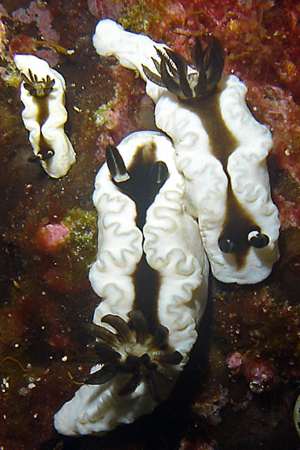
Glossodoris tibboeli
Valdés & Adams, 2005
Order: NUDIBRANCHIA
Suborder: DORIDINA
Superfamily: EUDORIDOIDEA
Family: Chromodorididae
DISTRIBUTION
Known only from Sulawesi, Indonesia
PHOTO
Locality: Para Island, Sangihe Archipelago Sulawesi, Indonesia. Depth: 10-15 meters. Indonesia. Length: 15-25 mm. 14 June, 2005. Coral pinnacle. Photographer: Hans Tibboeli
Similar in shape to Glossodoris atromarginata, with a high muscular body and narrow mantle skirt which is reduced on each each side to a sinuous ridge. It is bright white, except for a brown median dorsal band on the mantle running from in front of the rhinophores to just behind the gills. The band varies in width, widening to include the rhinophores, anteriorly, and the gills, posteriorly. The rhinphores stalk is white and the club is dark brown to black with a white line up the anterior and posterior midlines. The simple gills are translucent brown in colour. The mantle edge appears translucent greyish, apparently through the absence of opaque white pigment right at the edge of the mantle.
There is a single submarginal row of large discrete mantle glands, as found in G. atromarginata and other member of the Glossodoris atromarginata colour Group. The radular teeth are also similar in shape to those of G. atromarginata.
-
Valdés, A. and Adams, M. J. (2005) A new species of Glossodoris (Mollusca: Nudibranchia) of the Glossodoris atromarginata Colour Group, from Indonesia. Pacific Science, 59: 603-608.
Rudman, W.B., 2005 (November 20) Glossodoris tibboeli Valdés & Adams, 2005 . [In] Sea Slug Forum. Australian Museum, Sydney. Available from http://www.seaslugforum.net/find/glostibb
Related messages
Two little nudibranchs I haven't seen before [1]
July 30, 2007
From: Harry Blalock
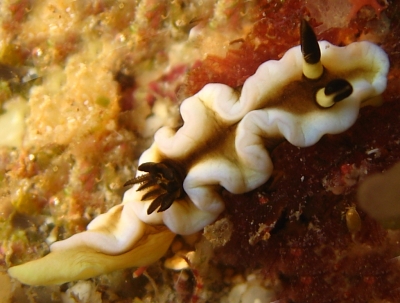
Dear Bill,
During the Halgerda mating weekend [message #20305 ], I also happened to stumble across a couple other nudibranchs I haven't seen before. The brownish one was about a half inch long, and the other was only about a quarter of an inch long. Can you help me with ID's on them.
Locality: Grotto, a cavern, 40', Saipan, Northern Mariana Islands, Pacific Ocean, 22 July 2007, On a big boulder covered with maroon colored vegetation.. Length: 1/2" & 1/4". Photographer: Harry Blalock.
Thanks,
Harry
harryblalock@gmail.com
Blalock, H., 2007 (Jul 30) Two little nudibranchs I haven't seen before [1]. [Message in] Sea Slug Forum. Australian Museum, Sydney. Available from http://www.seaslugforum.net/find/20307Dear Harry,
Please read my message earlier this month about sending messages [#20103]. It really wastes my time having to split messages up inot separate species. The reason I need messages split into separate species where possible is so that they can be stored under the appropriate species Fact Sheet and so be easily found when someone is looking for information about a particular species.
Your first species is a species of Glossodoris, almost certainly Glossodoris tibboeli.
Best wishes,
Bill Rudman
Re: Glossodoris dendrobranchia?
February 5, 2007
From: C. Carlson & P. J. Hoff
Concerning message #19357:
Bill,
We have only recorded 21 specimens & that includes 3 or 4 w/black line (= G. atromarginata ). For some reason the one issue of Pacific Science that had the description of Glossodoris tibboeli is missing from our library. It appears though that the 'species' we had earlier separated as 'c.f. atromarginata' pretty well matches up with G. tibboeli. As well as Guam, it also occurs on Saipan as well as Sarigan and Asuncion in the Northern Marianas. Our largest measured specimen is 35 mm -- none show any secondary folding like the one on the Forum and in all samples the gray mantle edge line is relatively straight. I have also seen a scan of one that appears to have branched branchia -- so our records don't help at all!
Clay Carlson & Patty Jo Hoff
ccarlson@guam.net
Carlson, C & Hoff, P-J., 2007 (Feb 5) Re: Glossodoris dendrobranchia?. [Message in] Sea Slug Forum. Australian Museum, Sydney. Available from http://www.seaslugforum.net/find/19385Dear Clay,
Thanks for your help. It would have been nice if you could have provided a simple answer, but simple answers aren't that common. Certainly I would expect a more wavy or folded line in larger specimens than in smaller specimens but I guess we will need to wait until more observations are made on this species.
I am a little hesitant to identify Glossodoris cf atromarginata with G. tibboeli because there seem to be quite a few 'hidden' species with very similar colour patterns, but I think the practical approach here is to tentatively identify all these Marianas Ids records as G. tibboeli.
Best wishes,
Bill Rudman
Re: Glossodoris dendrobranchia?
February 1, 2007
From: Lindsay Warren
Concerning message #7414:
Dear Bill
I have just been looking through the various species in the Glossodoris atromarginata colour group and wonder whether the specimens featured on the G. cf atromarginata page are in fact further examples of Glossodoris tibboeli Valdés & Adams, 2005?
Looking forward to your thoughts.
All the best
Lindsay
lwarren@datonomy.co.uk
Warren, L.C.R., 2007 (Feb 1) Re: Glossodoris dendrobranchia?. [Message in] Sea Slug Forum. Australian Museum, Sydney. Available from http://www.seaslugforum.net/find/19357Dear Lindsay,
You could well be right. My only doubt is that in larger specimens of G. tibboeli the edge of the mantle has a very sinuous greyish line, while in the larger specimens of G. cf. atromarginata there seems to be no sign of this secondary folding although the animals are longer. Usually, species of Glossodoris develop the secondary folding as they grow larger. Perhaps Clay Carlson, who has collected many specimens, could check and let us know whether there is any correlation between length of animal and degree of folding at the mantle edge.
Best wishes,
Bill Rudman
A new species of Glossodoris from Sulawesi
November 21, 2005
From: Mary Jane Adams
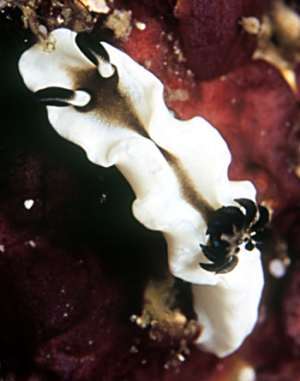
Hi Bill,
I would like to introduce a new Glossodoris species from Indonesia that recently described by Angel Valdes and myself. Glossodoris tibboeli is easy to recognize by its starkly white body and distinctive dark brown dorsal stripe that begins in front of the rhinophores and ends immediately behind the gill. Adults have a crawling length of about 25 mm. So far, G. tibboeli is known only from a few small islands in the Sangihe Archipelago about 90 miles north of the northern tip of Sulawesi, Indonesia.
Locality: Para Island, Sangihe Archipelago, Sulawesi, Indonesia. Depth: 10 meters. Length: 25 mm. 13 June 2004. Coral pinnacle. Photographer: M.J. Adams
Hans Tibboel, an Ocean Rover divemaster and branchophile, first noticed this slug while diving on an offshore pinnacle near Para Island in June 2004. He photographed it with his new digital camera and asked me if I could identify it. We searched through every book in the boat's library, but couldn't find a picture like it. Although I had skipped the morning dives due to illness, I suddenly felt well enough to do the next dive at this site. I was nearly out of air and beginning my ascent when I came across twelve of these distinctive slugs clustered together on a dark colored sponge.
On a return trip to Northern Sulawesi in June of 2005 Hans found large aggregations of G. tibboeli at the same divesite. On one dive he counted over 100 G. tibboeli concentrated on sponges on the exposed side of the pinnacle. He has also seen of G. tibboeli in smaller numbers at other dive sites on Para Island, Kahakitang and Mahengetang Islands. I have included some of Hans' images in a second message.
-
Valdés, A. and Adams, M. J. (2005) A new species of Glossodoris (Mollusca: Nudibranchia) of the Glossodoris atromarginata Colour Group, from Indonesia. Pacific Science, 59: 603-608.
Best wishes
Mary Jane Adams
divepng@yahoo.com
Adams, M.J., 2005 (Nov 21) A new species of Glossodoris from Sulawesi. [Message in] Sea Slug Forum. Australian Museum, Sydney. Available from http://www.seaslugforum.net/find/15043Dear Mary Jane,
Thanks for this. It is another interesting addition to the 'G. atromarginata - group' of species.
Bill Rudman
More photos of Glossodoris tibboeli
November 21, 2005
From: Mary Jane Adams
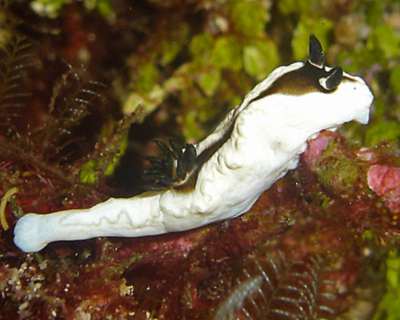
Hi Bill,
Following on from my other message, here are some of Hans Tibboeli's photos of Glossodoris tibboeli.
Locality: Para Island, Sangihe Archipelago Sulawesi, Indonesia. Depth: 10-15 meters. Indonesia. Length: 15-25 mm. 14 June, 2005. Coral pinnacle. Photographer: Hans Tibboeli
Best wishes,
Mary Jane
divepng@yahoo.com
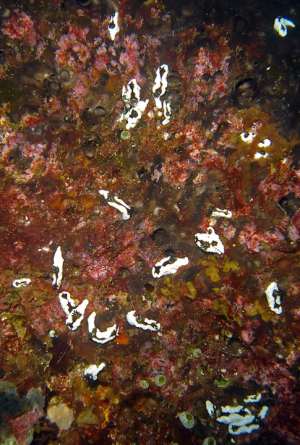
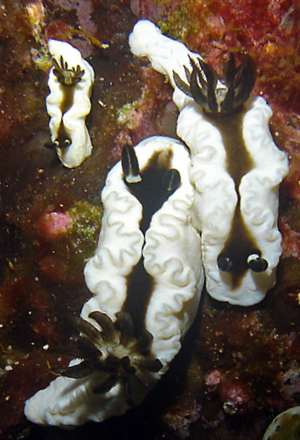
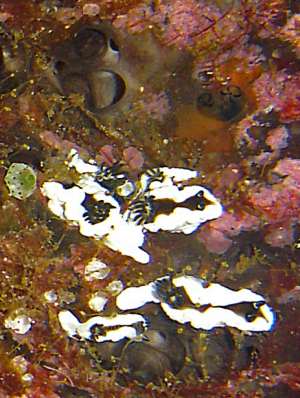
Dear Mary Jane,
Thanks for these photos. It certainly seems to have found what it likes to feed on. I suspect it is either a spongiid or thorectid, but they are sometimes difficult to tell apart even with specimens. So many animals present fits with your suggestion that this could be a direct developing species. It would be useful to confirm that the 'possible' egg ribbon in your paper does belong to this species. If you are in contact with Hans Tibboel it might be interesting if he kept an eye out for egg laying so we can confirm just what this species' eggs are like.
Best wishes,
Bill Rudman
Re: Glossodoris dendrobranchia?
July 11, 2002
From: Nishina Masayoshi
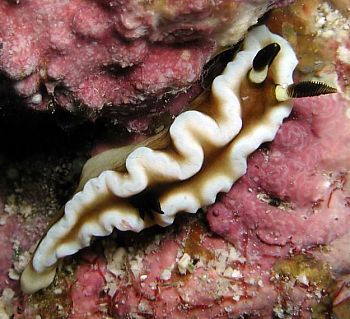
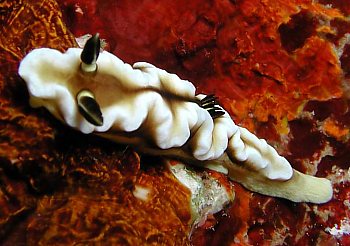
Note added 5 Feb 2007: This is most probably Glossodoris tibboeli [see message #19385]
Dear Bill,
To accompany my last message here are some more individuals which we found in the latest Saipan trip. All these animals were found shallower then 12m and size were around 30mm. All photos were taken where we saw them.
April 13, 2002
Saipan Island, Micronesia.
Photo by M.& C. Nishina
Best Regards,
Nishina Masayoshi
nishina@wips.co.jp
Masayoshi, N., 2002 (Jul 11) Re: Glossodoris dendrobranchia?. [Message in] Sea Slug Forum. Australian Museum, Sydney. Available from http://www.seaslugforum.net/find/7414Thanks Nishina,
Bill Rudman
Re: Glossodoris cf. atromarginata from Guam
June 29, 2002
From: Clay Carlson
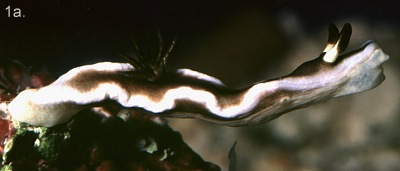
Bill,
Concerning our earlier message on this animal without a black border which we think is a variety of G. atromarginata. Here are some other Guam examples. Photo 1a doesn't show much except it is the whole animal for Photo 1b. This is an example of the faint marginal line. It actually extends further on the animal but the scanning process wiped some of it out.
• Photo 1a: 24mm; Guam, Pago Bay, 24m; 31 July 1987. Showing indistinct line along mantle edge]. Photo 1b: Enlargment of head area of Photo 1a.
• Photo 2: Glossodoris atromarginata (Cuvier, 1804); 29mm; Guam, Bile Bay, 6m; 23 May 1971. Typical G.atromarginata with black mantle border.
• Photo 3a: size?; Guam, Tanguisson, 8m; 5 March 1971. No black margin except for trace around posterior edge (see Photo 3b).
Clay
clay.carlson@kuentos.guam.net
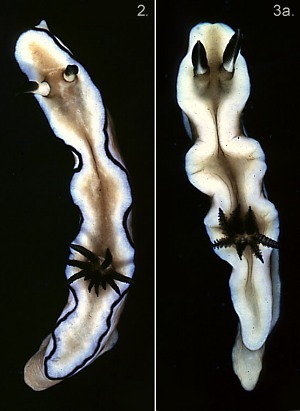
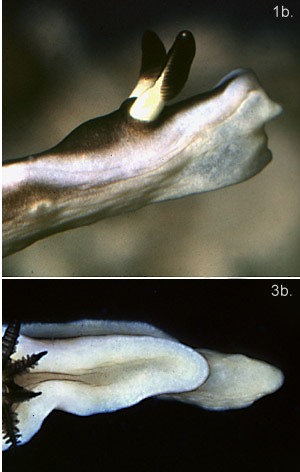
Note added 5 Feb 2007: This is most probably Glossodoris tibboeli [see message #19385]
Thanks Clay,
I have hunted through all my records and have never seen a specimen of G. atromarginata which even looks like it is losing its black margin. That is not to say it doesn't occur in Guam. It would certainly be worth looking at least at the radula to see if there was some obvious difference in shape or size from 'typical' G. atromarginata. I have added an enlargement (3b) which seems to show a black edge to the posterior part of the mantle. It may represent the upper edge of dark pigmentation on the sides of the body but from above certainly looks like a black edge.
Cheers,
Bill Rudman
Re: Glossodoris dendrobranchia? from Guam
June 27, 2002
From: Hisako Sato
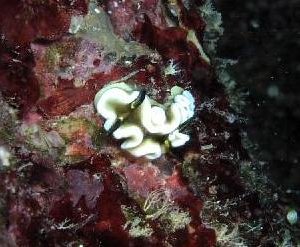
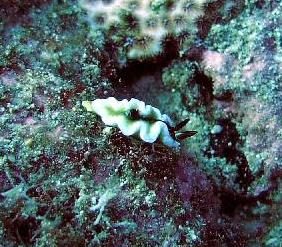
Dear Bill
Thank you for your reply. Might this be a new species??? I'm sending you other photos.(Regrettably,there isn't good photo because I'm still awkward with camera. Sorry!)
I think the best dive site to see lots of this is SHARKS PIT in Guam. (I have never seen it at other site.) If I search carefully, I can see four or five of this in one dive.
I'm looking forward to find some new thing.
Thanks again for your help.
Best wishes,
Hisako Sato
usausacchi@hotmail.com
Sato, H., 2002 (Jun 27) Re: Glossodoris dendrobranchia? from Guam. [Message in] Sea Slug Forum. Australian Museum, Sydney. Available from http://www.seaslugforum.net/find/7378Note added 5 Feb 2007: This is most probably Glossodoris tibboeli [see message #19385]
Dear Hisako,
Thanks for the photos. You will see we have had comments from Clay & Patty-Jo and Nishina Masayoshi. It is possible it is a form of Glossodoris atromarginata but I think we would need to check it anatomy before we could be sure.
Best wishes,
Bill Rudman
Glossodoris dendrobranchia from Saipan
June 27, 2002
From: Nishina Masayoshi
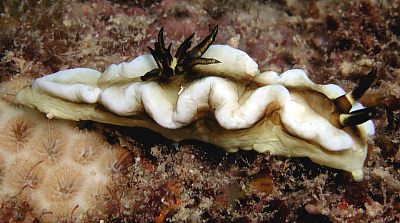
Dear Bill,
I dived at Saipan Island, Micronesia in April. I saw 4 individuals of this animal in 4 tanks dive. So this animal is may be common around this area. I thought it is G. atromarginata till I saw Hisako Sato's message today. I hope you can see gill in this photo.
Date: 12 April, 2002
Location: Saipan Island
Depth: 12m
Length: 30mm
Photographed by N.Chikako
Best Regards,
Nishina Masayoshi
nishina@wips.co.jp
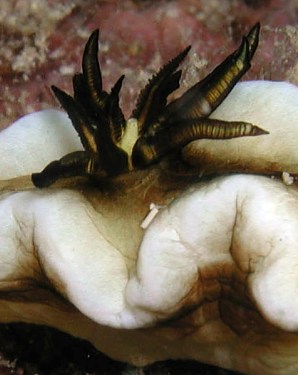
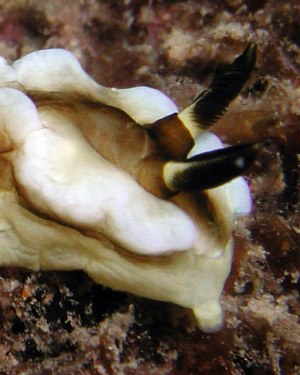
Note added 5 Feb 2007: This is most probably Glossodoris tibboeli [see message #19385]
Thanks Nishina & Chikako,
It certainly clarifies the shape. The gills are quite different from the slender, sometimes branching gills of G. dendrobranchia. Clay & Patty-Jo think this is probably a colour form of G. atromarginata but I would like to see its anatomy before agreeing.
Best wishes,
Bill Rudman
Re: Glossodoris dendrobranchia? from Guam
June 27, 2002
From: Clay & Patty Jo
Bill,
We are treating this animal, as well as the black margined form, as G. atromarginata. All have dark brown/black lamella on the rhinophores and the branchia are the same color. The 'stalk' of the rhinophores is yellowish. Some of our photos show a faint off-white line where the black margin would be expected. There could be two species involved, but at this point in time we doubt it.
Clay & Patty Jo
ccarlson@kuentos.guam.net
Carlson, C. & Hoff, P.J., 2002 (Jun 27) Re: Glossodoris dendrobranchia? from Guam. [Message in] Sea Slug Forum. Australian Museum, Sydney. Available from http://www.seaslugforum.net/find/7371Note added 5 Feb 2007: This is most probably Glossodoris tibboeli [see message #19385]
Thanks Clay & Patty Jo,
I have just received a message from Nishina Masayoshi with an excellent photo taken by his wife, Chikako, illustrating the colour points you mention above and showing that it doesn't have the branching gills of G. dendrobranchia. It certainly has similarities to G. atromarginata, but so does G. sibogae. So that this 'colour form' doesn't get lost I think I'll put it on a Glossodoris cf. atromarginata page until someone has a look at its anatomy.
Cheers,
Bill Rudman
Glossodoris dendrobranchia? from Guam
June 25, 2002
From: Hisako Sato
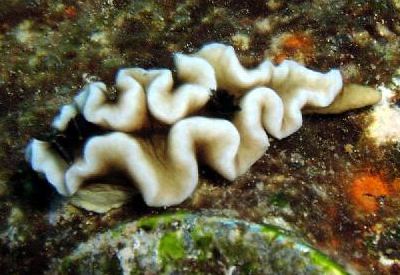
Hello.
I'm a Japanese amateur diver. I hope you will give me some advice. I took a photo of this sea-slug in Guam. (13 June 2002/depth of 16 meters). Whenever I go to there, I can see this. I think this is common sea-slug in Guam. I'd like to know its name but I have been unable to find one for it.
If you know its name, could you please tell me.
With best regards,
Hisako Sato
usausacchi@hotmail.com
Sato, H., 2002 (Jun 25) Glossodoris dendrobranchia? from Guam. [Message in] Sea Slug Forum. Australian Museum, Sydney. Available from http://www.seaslugforum.net/find/7307Note added 5 Feb 2007: This is most probably Glossodoris tibboeli [see message #19385]
Dear Hisako,
This is a species of Glossodoris, and it looks very like Glossodoris dendrobranchia. But in that species the gills and rhinophores are pale creamy white and in your photos they seem to be dark brown. One thing that puzzles me is that you say you find this species commonly at Guam. G. dendrobranchia is only known from a few records from the Great Barrier Reef, and I am pretty sure it has not been recorded from Guam.
Have a look at the page on Glossodoris atromarginata which is a species which can be very similar in colour to your photo but has a dark brown or black line at the edge of the mantle. It is a common species throughout the tropical Pacific and Indian Oceans and occurs in Guam.
It is of course possible that this animal with no black edge is common in Guam, but if so it is a very interesting find. If you have other photos that show the gills I would like to see them. In the meantime I am sure Clay Carlson, who has many years experience in Guam, will be able to help us out.
Best wishes,
Bill Rudman
